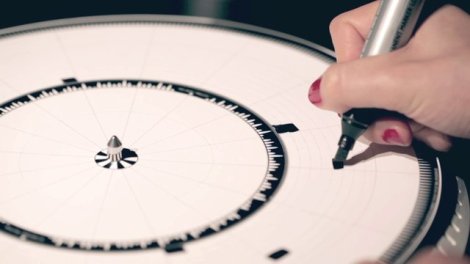
The Dyskograf lets you make music with a magic marker. The musical installation looks much like a turntable for playing vinyl records. But instead of a spiraling groove containing the sounds, this uses marks on a paper disk to play sound samples.
You can see the light outline of several tracks on the paper disc shown above. By adding black marks the optical input of the Dyskograf knows when to start and end each sound. This is best illustrated in the video demonstration after the break.
The marker-based setup makes a lot of sense, and we think it would be perfect if the disc was a dry-erase board. It certainly makes it a lot easier to lay down new beats than this other optical turntable which required holes to be drilled in a vinyl record to play the sounds. While we’re on the topic you may also find this coin-based turntable sequencer of interest.
[Thanks Petrus]
















it’s like a more labor intensive version of the monome, still cool though http://youtu.be/cJwxbTKwONc
It’s like this project that was showcased on the Processing website some time ago: http://www.the-product.org/soundmachines
Very cool.
Cover the disk with magnetic tape. Draw on it with a tapehead writer, read with a second tapehead on the arm. Can’t remember where i’ve seen it but the sounds that came out were awesome.
http://www.youtube.com/watch?v=Xpr7B-7BFP4
did not mean to hit report.
Was that Jeri Ellsworth video what you were thinking of?
It’s the same principle, but not what I was looking for. In the demo I saw they had 2 surfaces: a disc the size of a record and a square surface that had the dimensions of a kitchen chopping board. Both were laminated with black magnetic tape (I think from VHS tapes). There was a pen with a little disk writing head at the end – the cube ones you find in cassette players. The person scribbled on the surface while putting a signal on the write-head. He then switched the pen to “read mode” and scribble again, this time you heard sounds each time the pen passed an area where he scribbled. The second part of the demo was with a circular board on the turntable with a separate fixed reading pen.
Ooh neat!
Idea:
Do it with a dry-erase surface, instead of magic markers on paper.
You’d have to change the drive mechanism, but imagine erasing and re-drawing parts of the track as the disk spins!
Yep dry-erase discs is a good idea, I think another neat mod would be to replace the disc with a large paper scroll, it would give you a lot more data storage. Oh and have they tried writing words on the disc? That would sound weird.
Dry erase is a good idea, but what about magnets/mass? Perhaps this is a good application of pennies…
http://en.wikipedia.org/wiki/Oramics
what about glow-in-the-dark material as a carrier?
like this : twitbot
I like the optical readout, instead of all the suggestions of getting rid of it I think we should find more ways to utilize that, like for instance hanging a cam over an area of a schoolyard and rotate the cam (or process the picture output of it as such) and then have kids draw patterns on the ground or even have the kids themselves be the pattern by standing in the right spot.
You also scan linearly but I think it’s more fun for kids/people when it’s a circle.
Perhaps the mother of all optical synthesizers is one particular instrument (I forget the name) which was built in the 1930s in Soviet Russia and has been recently restored. It uses large stencil-cut sheets of film as the control media. It is fully polyphonic, each cut in the stencil controlling a different generator (there are over sixty of them if I remember correctly).
When someone writes an post he/she maintains the image of a user
in his/her mind that how a user can be aware of it.
Therefore that’s why this article is great.
Thanks!